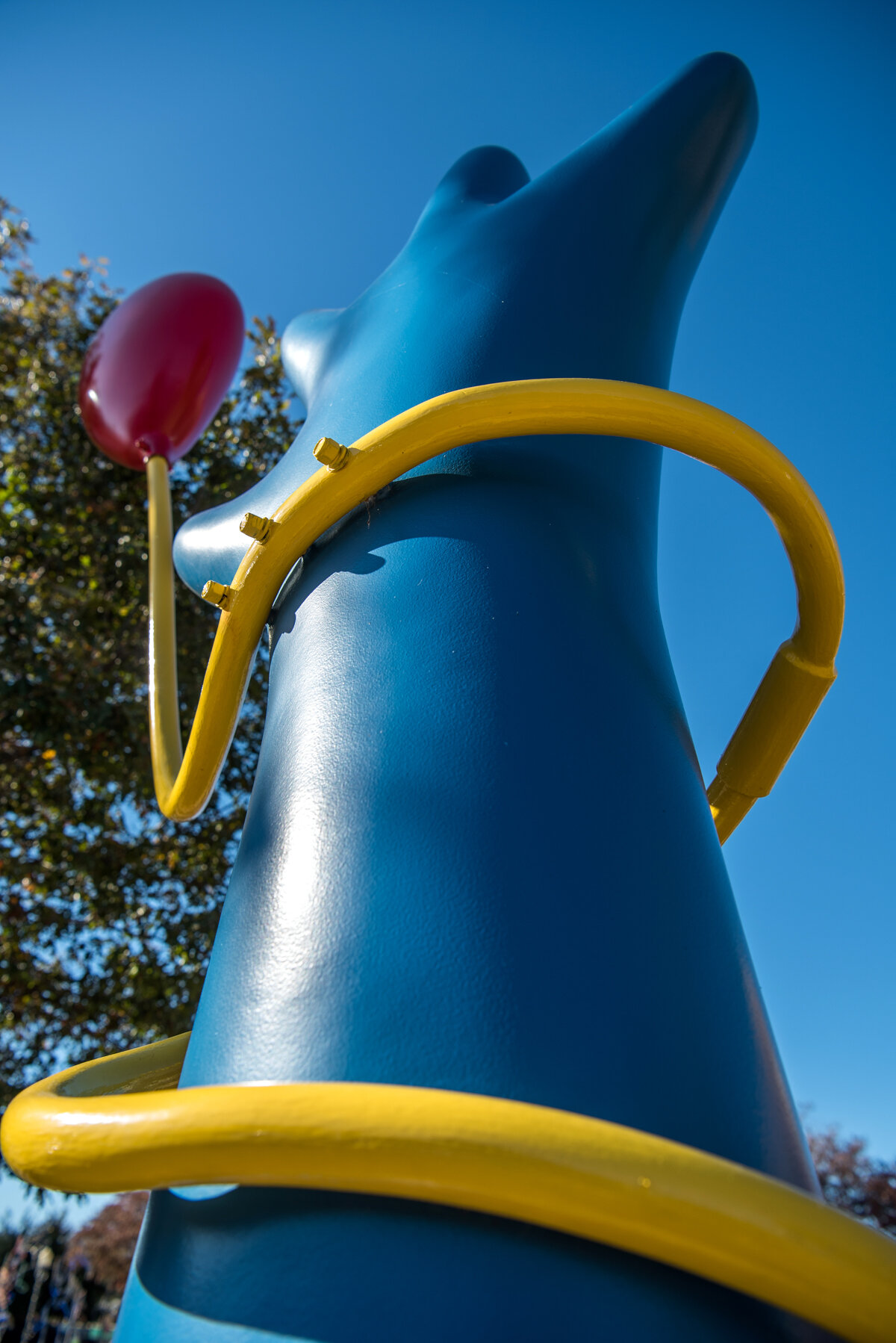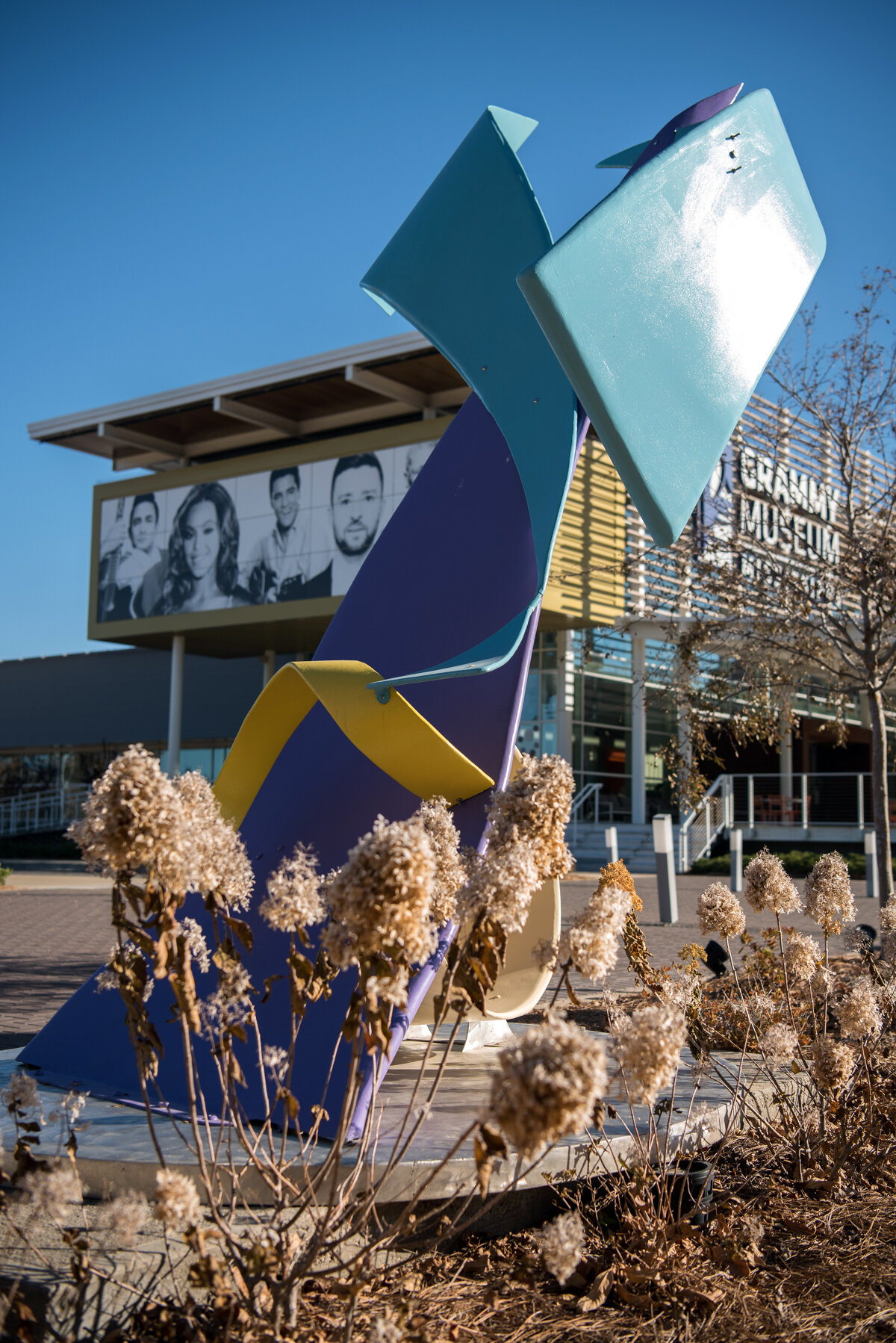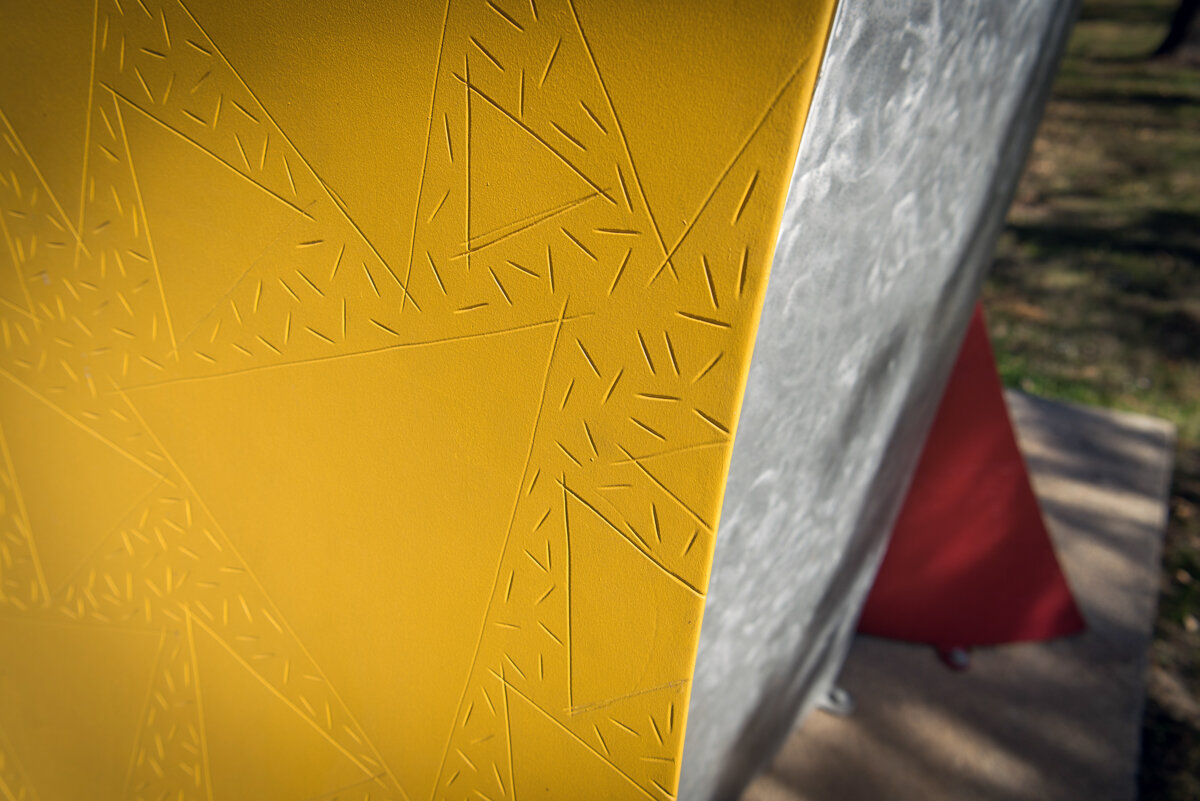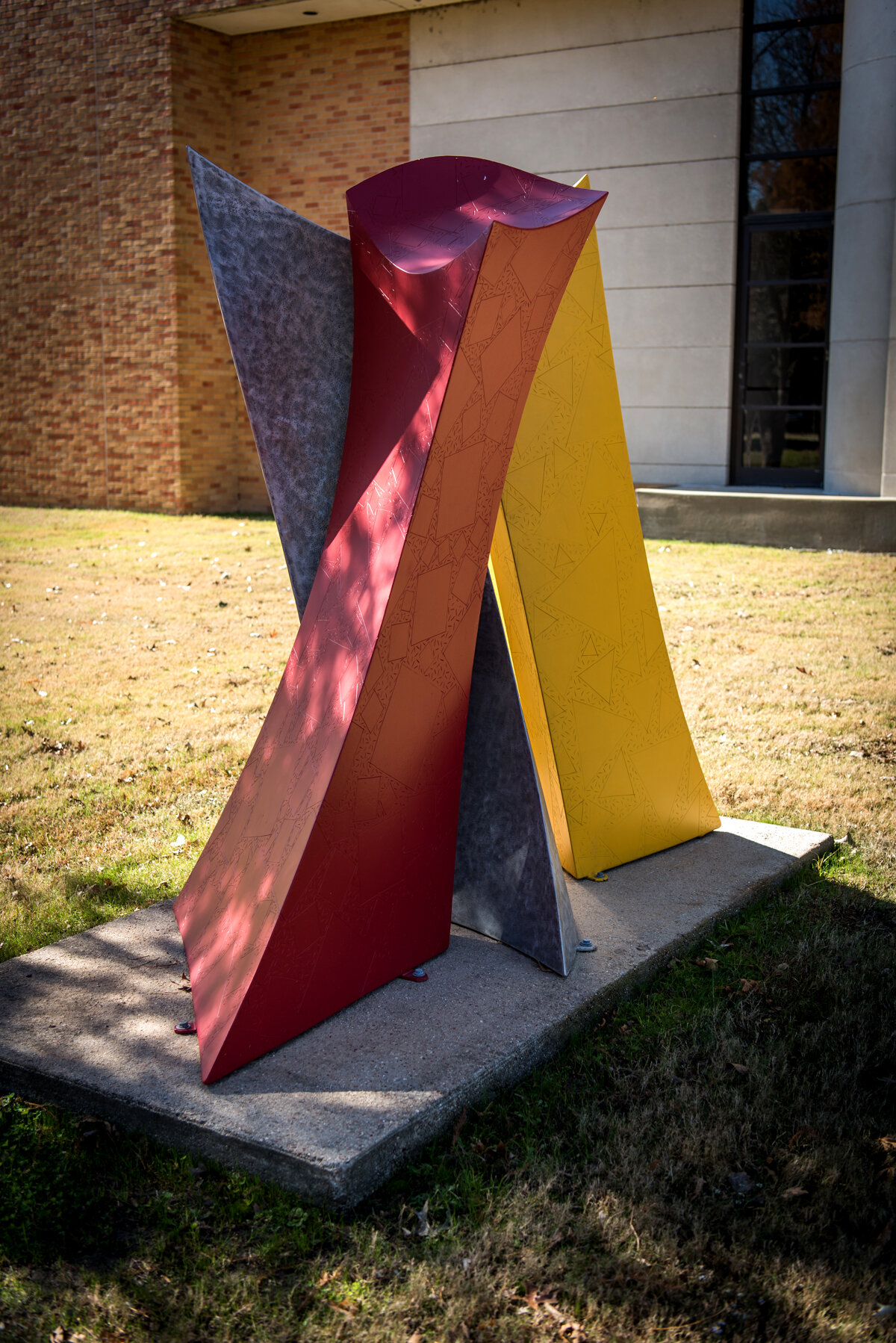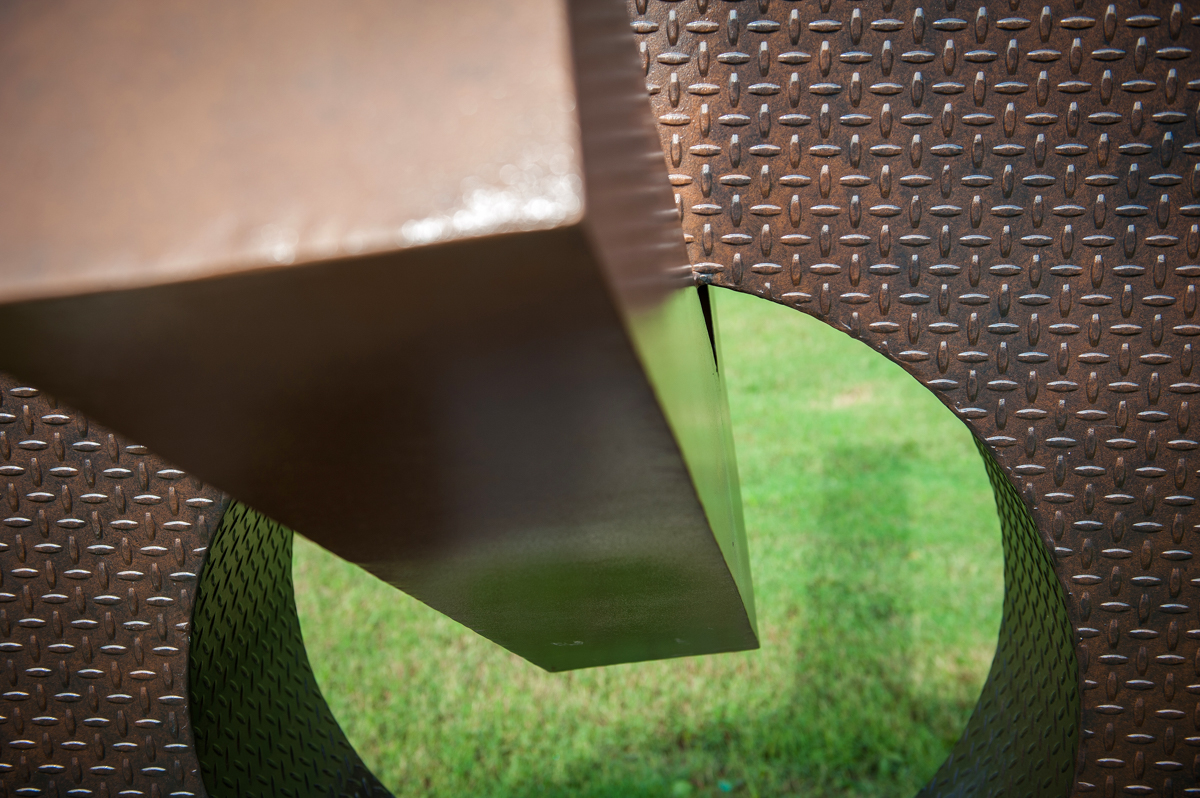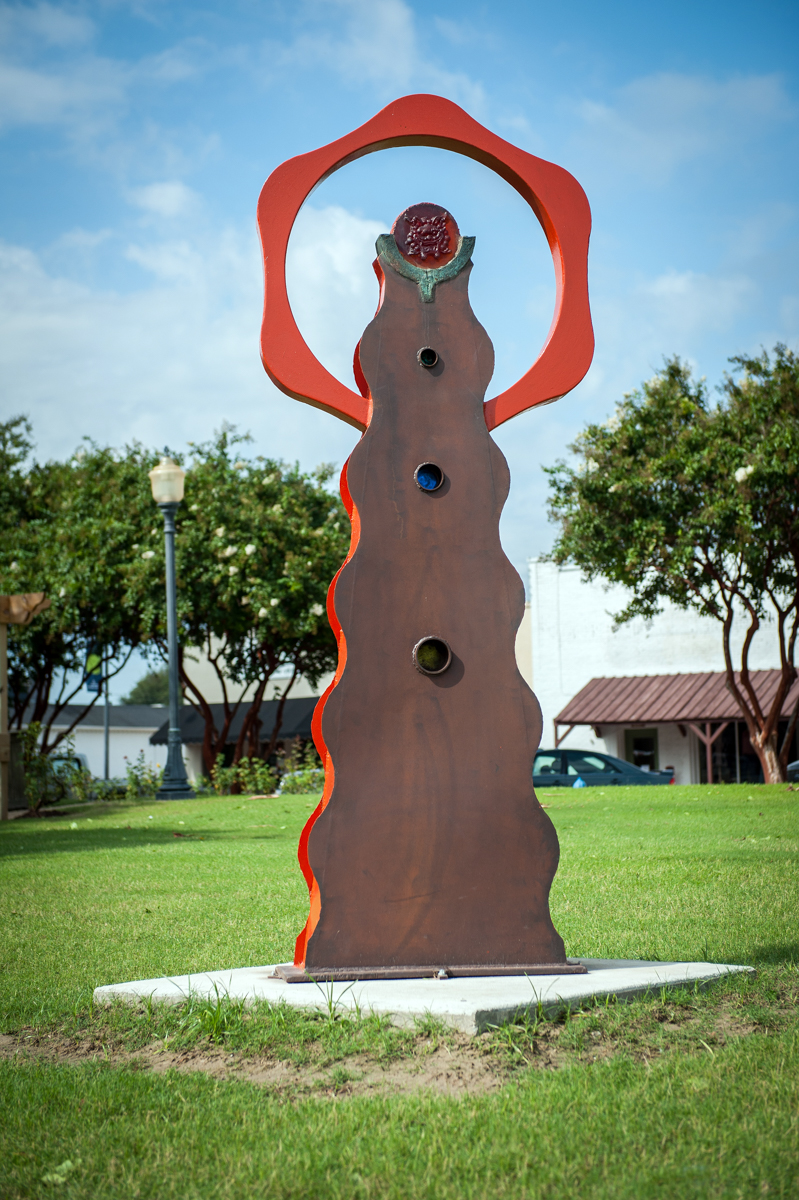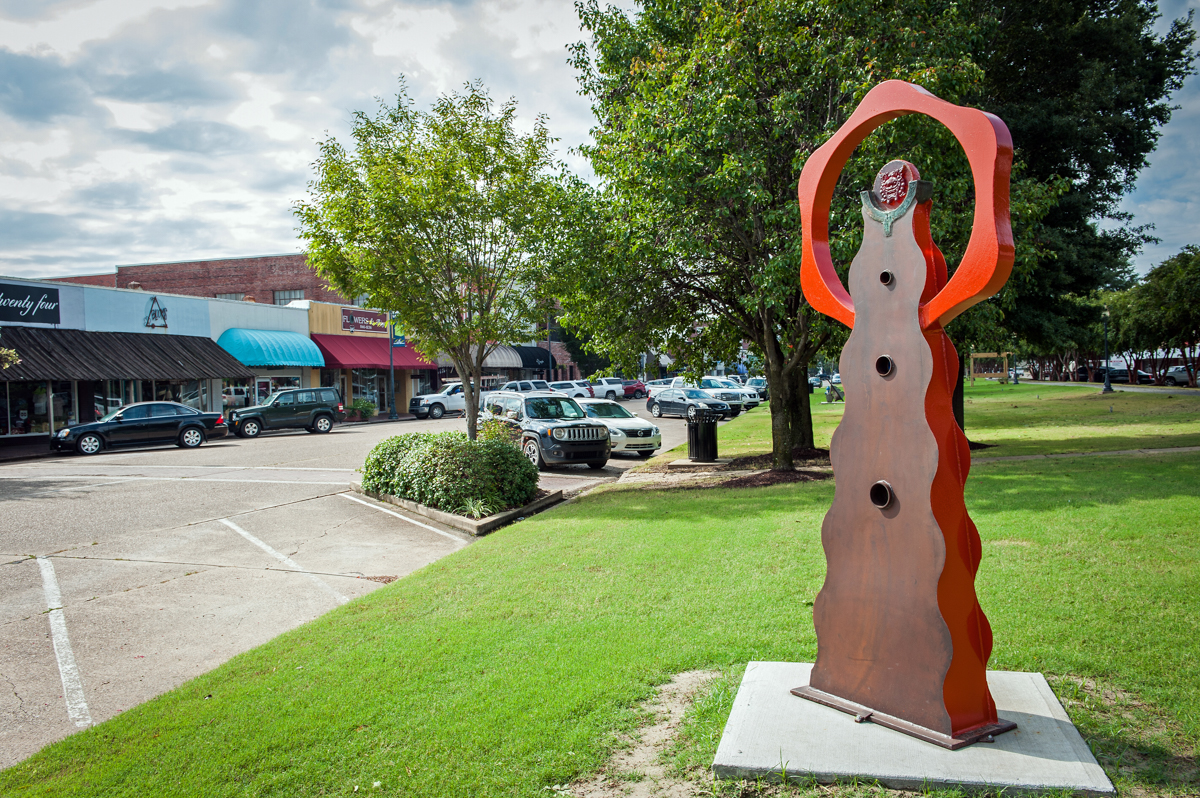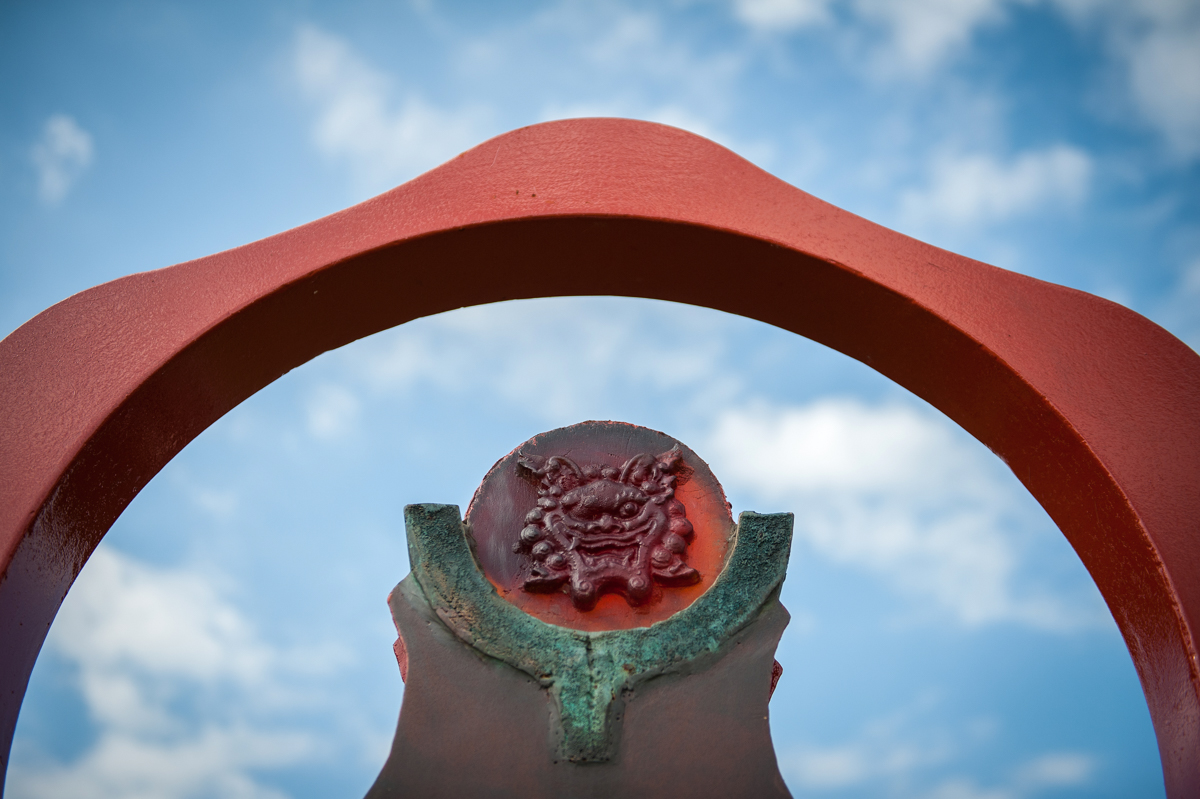Abstract. In a word, revered, veteran sculptor Ray Katz describes his compositions – most especially this year’s entry King of Spades – as “(My sculpture is) abstract – the abstract manipulation of form in space to create visual balance, using rhythm, action and movement.” The Michigan metal man continues, “My creative process requires organizing separate parts into a whole. I first fabricate all separate, solid, active pieces, and then let the process of creating happen organically and quite spontaneously, very instinctively and intuitively.” The puzzle-like assemblage “adds to the aura of complexity in the work. These activated forms are brought together to represent the flux of life and embrace transformative concepts such as evolution, metamorphosis and transcendence. This is what continually inspires me, continually allows me to ground to explore,” Katz concludes.
Sustainable Flower by George Tobolowsky
After several decades positioned as a successful businessman and lawyer, George Tobolowsky transitioned to full-time artist and in less than 15 years, has produced over 550 sculptures that are permanently homed in just less than 60 public, private and museum collections. Tobolowsky makes abstract metal sculptures from steel and stainless steel “found objects” – or rather bulky industrial metal castoffs that he faithfully scours scrap yards and fabrication plants to find. Rarely altering these metal pieces, the Dallas native instead works to fit the individual scraps together – much like the pieces of a jigsaw puzzle – into a balanced composition. “My sculptures are one part assemblage and one part recycling, which follows closely with the philosophy of another early artistic influence and mentor, Louise Nevelson,” Tobolowsky adds.
Hill Climb by Jim Collins
A newcomer to the Mathews-Sanders Sculpture Garden, Jim Collins is an accomplished artist with studios in both Chattanooga, Tennessee and Highlands, North Carolina. With over forty years of experience, Collins first began his career in wood carving, before transitioning to painting and later to public art in 1970, with his collection’s signature piece, The Viewer, being born in 1977. His sculpture style has been characterized by the use of silhouettes of people and animals constructed of stainless steel, aluminum and other metals. Fabricated in 2019, Hill Climb stands 10 ft. tall and is compromised of five cyclists on an upward climb, hence the name; although Collins cautions, “I try not to put too much value in the name of a piece. I don’t want it to lead a viewer’s interpretation of the piece.” He continues, “Sculpture is to be understood by the viewer, to be experienced by the viewer – not the artist.”
Hold On / Let Go by Lawson King
Returning for his second consecutive competition class, Mississippi Delta native and Delta State University graduate, Lawson King has been apprenticing for public art veteran and venerable sculpture rock star, Ray Katz – also a fellow exhibitor, this year. “Ray and I met at the previous installation here in Cleveland, and it was quick. We were bonded right away; he’s an amazing soul and an inspiration – a true mentor,” King lauds. “My time in Pontiac (Michigan) has taught me so much, I’m learning everyday about my craft, my desires, my vision – everything really.” Those lessons learned are in full display in his newest piece, Hold On/Let Go. Challenging himself more than he has with any other piece, this 12 foot, fiberglass and steel tubing construct offered King fertile ground to survey his newest thematic exploration – control. “I think the balloon in the piece is metaphoric; it represents our desire to hold on, to think we are in control; but a balloon can slip out of our hands quickly. So is it better to surrender control, to let go?”
SCBS #12 by Matt Amante
“I make because I have to make,” Matt Amante declares. “I am wired to make and can’t not make. It, really, kind of, is that simple.” His innate desire to “make things” and create are the exact reason this newcomer to the Mathews-Sanders Sculpture Garden debuts with two pieces – one in the downtown collection and one in campus collection at Delta State University. SCBS #12 features stainless steel and precisely placed river rocks, bringing the piece to 74 inches tall and 18 inches wide. “I can get obsessive with a certain theme and I am motivated by exploring that series, whatever it is, all the way out. There are several in this self-study series. I’m excited to see how this piece lives in your downtown space.”
Ojai by Wayne Vaughn
Now his second time to exhibit work in downtown Cleveland and his fourth time to be presented in the biennial competition, Wayne Vaughn brings one of his more “whimsical” pieces in Ojai. Featuring a playful composition of colored paint and patina steel, this sculpture pays homage to Ojai, California – a place Vaughn, himself, has never visited. “One of my earliest supporters, Dr. Charles Millard with the Ackland Art Museum in Chapel Hill (North Carolina) had property in Ojai and he always spoke so lovingly, so warmly about this place. I was moved by that and I also wanted to honor him for the role he played at the start of this journey.” Vaughn continues, “I love to bring animation to cold, hard steel. My hope is that my work invites the viewer to play, question and respond – that or just a child’s smile will do.”
TIPO 3333 by Kevin Trobaugh
Kevin Trobaugh proudly makes his debut appearance inside the state of Mississippi with his 2016 aluminum creation, Tipo 333. A 30-plus year sheet metal worker and welder, this retired O’Fallon, Illinois resident saw beauty in the shapes and metals of his craft. Yearning to take the experienced fabrication skills of his day trade to a more creative and challenging artform, Trobaugh found sculpture to be a perfectly rewarding outlet. His public art journey began in 1991 and he explored both free-standing and kinetic pieces, with permanent placements in private homes, gardens and municipal parks. “I am honored to have this piece be displayed at The Grammy Museum Mississippi,” Trobaugh shared. “There is certainly unintended musical hints and references in this piece, and I have been asked do I play the harp.” Laughing, he finished, “The answer is no.”
Learning Curve by Frederick Napoli
A first-time exhibitor with the Mathews-Sanders Sculpture Garden, Frederick Napoli delivers Learning Curve from Lake Zurich, Illinois. Approximately nine feet tall, the sculpture consists of five separate forms and a base, and is made of welded aluminum and painted in bright hues. A curvilinear sculpture, this piece manipulates space to represent motion through implied momentum, positive and negative spatial juxtaposition, and tension and release. “Colors and shapes can suggest peace and tranquility, or the opposite, such as discomfort, conflict and our difficulty navigating through daily tasks,” Napoli explains. “I have attempted to address the paradox everyone faces as inhabitants of a changing world through the interaction created by sculptural form colored in various hues with the suggestion of elements in constant motion.”
Greatest Sum by Taylor Barnett
An admitted “obsessive forager,” Taylor Barnett jokes, “I have the hardest time looking up. I am constantly looking at the ground, surveying for pieces – whatever those may be, bottlecaps that strike me interesting, rocks that catch my eye, small glass pieces that shine brightly. I find infinite beauty in those cast offs – whether by human hand or nature.” This capturing of “what others don’t see or choose not to see value in” started early in her childhood and set the eventual path for Barnett’s inaugural entry into the Mathews-Sanders Sculpture Garden, Greatest Sum. “This piece centers solely on that idea of cast offs and repurposing those, reinventing them, reimagining their story and meaning and paying close attention to what happens when these scraps, throw-aways, delinquent cast offs deemed unnecessary and impure in someone else’s art or story merge and unite in this piece to reveal great power and beauty and strength.” A Mississippi native, Barnett admits, “The time I spend organizing these pieces into a skeleton design, the time I’m on the ground moving and removing, adding and subtracting pieces to tell these stories or the story; man, that’s it, right there. That’s play time for me. That’s the ‘why’ to why I do this.”
Triumphal Arch by Robert Porreca
A Pittsburgh, Pennsylvania native, Porreca bucked family roots, trading the eastern coal mines for an art studio. “At the great behest of my family, I went into the arts and was an art teacher for 30-plus years,” he explains. “I didn’t always have the time to market my own art because when I got home from school, I was Dad to three girls. I’m retired now; I have the time and I’m doing it.” And “doing it,” big – literally, as Triumphal Arch stands 9 feet tall and is constructed of epoxy resin, fiberglass, carbon fiber and some hidden polyvinyl chloride pipe for support. Of the inspiration, Porreca explains,“Maquette after maquette, I just couldn’t let this idea go. I wanted to combine this idea of a Roman triumphal arch and the Greek Winged Victory of Samothrace, also called the Nike. What I’ve brought is my interpretation of these two powerful things that I’ve been fascinated with for some time and how they would look combined. I just had to make this piece.” But then again for this renewed and energetic septuagenarian, making is his lifeline. “I have to make because I breathe. I breathe because I’m making art.”
SCBS #9 by Matt Amante
“The proverbial student,” Matt Amante proudly declares. Despite his professor moniker at Pitt Community College in Winterville, North Carolina, Amante insists, he is no different than the very students he instructs. “Might I have more experience than them? Sure, yes; but I’m still a student. I don’t stop learning. I don’t think anyone should ever be completely through learning – not as artists, not as human beings. I would hope we share a yearning to constantly evolve,” he says. “That is the principle behind this piece, SCBS #9 – the second in the series I am bringing to Mississippi this year. It’s self-study challenge to only design with the circular forms and the river rocks.”
Spark by Phil Proctor
“Spark is an up-close look at that moment of energy released when a hammer strikes a piece of hot iron,” newcomer to the Garden, Phil Proctor explains. “It’s a point of view frozen in time.” Owner and proprietor of Nucleus Sculpture Studio in Georgia, the Mississippi native holds a Master of Fine Arts in Sculpture from East Carolina University and a Bachelor of Fine Arts in Sculpture from the University of Southern Mississippi and has been a professional sculptor practicing in Atlanta since 2003. “As a sculptor, I strive to design and execute artworks that intrigue and inspire a viewer about their place in an environment or space,” Proctor continues. “My work exhibits a relationship between our existence as a human species and the universe in which we exist, and I think that is particularly true with this piece. Spark is intended to encourage the viewer to observe a seemingly ordinary event from multiple perspectives – a technique which promotes open mindedness and critical thinking.”
Almagestum I by Jon Whitfill
“This piece is named after a book, which is arguably the most important scientific treatise written in the last two thousand years. All scholars across the globe in countless languages, and different regions studied this book to understand the nature of the spherical universe – which included the celestial sphere endlessly rotating around the motionless, spherical Earth,” newcomer Jon Whitfill brilliantly explains. “The fascinating thing about this wonderful tome is that almost all of it has been disproven in the past couple of hundred of years. The originator of this treatise, an astronomer named Claudis Ptolemy, knew that there was something wrong with his perfectly circular and spherical model of the universe, but no educated scholar could deal with the fact that heavens weren’t built with perfect circles and perfect spheres.” Counted among those resistant scholars is Whitfill, himself. A science “nerd” and physics teacher for over a decade, he continues, “I guess, I, myself, hold some of these prejudices against ellipses and other ovular forms that ancient scholars held. There is something about the circle, and a spinning circle forming a spherical shape that just makes my heart sing.” Almagestum stands 10 feet tall and is fabricated from powder-coated, welded steel. “This piece is everything about my earliest roots on display and I am proud to have it, here, on display among such a fine cadre of sculptures and artists.”
Intrusion by Harry McDaniel
One of seven rookie exhibitors to be featured in this year’s campus selections, Harry McDaniel brings Intrusion from his Asheville, North Carolina studio. Intrusion is constructed of steel, aluminum and powder-coat paint. “Intrusion was a piece that I made over the course of several years, and when I first began, I was working, primarily, in steel. I knew from my crude sketches and the maquette process, that I wanted the three pieces to be different colors; so when I finished fabricating the first piece and painted it red, it was still missing something,” McDaniel recalls. “So, I went to add texture by grinding and I really liked the way it was turning out, but I very quickly realized, this is going to take forever and it nearly did; so the truth is, by this point in the process, I was becoming more and more familiar with stainless steel and that’s why the third piece is not orange, as I had originally intended and instead, that stainless steel – which I think really adds depth to the piece.” This “happy timing,” as he refers to it now, gave Intrusion the depth necessary to accomplish McDaniel’s first goal with the piece. “I wanted to create an engaging sculpture that invited the audience to interact with it, to walk around it and experience it from all angles, all perspectives. I wanted the viewer to explore his/her relationship with space and the piece, just as this piece explores the relationship between three competing perspectives for space. You can really ask yourself from which side, which perspective is the intrusion coming?”
Amongst by Hanna Seggerman
The saying, “You never know when inspiration will find you,” could not be more true for Kingsley, Iowa native, Hanna Seggerman. While hiking along the Cedar Falls River, just minutes from her alma mater, the University of Northern Iowa, with her teeth chattering and her face burnt from the frost, she was undeterred, stubbornly determined to practice shooting with her new camera. “I think I was in Photo II class, and I knew I needed to be out there practicing. I knew I needed to be working with that camera. I’m looking at the river, the trees, the landscape all around me and then I see these rocks, placed so perfectly and they had ice so beautifully wrapped around them, almost like it was sewn. It was absolutely pristine, like beyond just pretty,” she describes. That photograph propelled sketches, which multiplied to more sketches and then finally a maquette, to what now houses property just left of the steps by the East Entrance of the Bologna Performing Arts Center. Just her second time to install this sculpture and her first time to install outside of Iowa, Seggerman adds, “My work is super personal to me, I think most artists would say that. Having a piece that so many complete strangers are going to come into contact with, that’s scary and completely exhilarating all in the same crazy breath. I would hope they see things that may appear so unconnected or share a juxtaposition, can grow with each other, can be close together, can work together. That’s a concept that is really interesting to me.”
Bluestone Blues by Glenn Zweygardt
Glenn Zweygardt continues his long-standing relationship inside the Mississippi Delta with his installation of Bluestone Blues. A venerable, New York-based sculptor, he has gained world-wide recognition over his nearly six-decade career and a membership to the Berman Group, a cooperative of sculptors whose collective work spans virtually the entire spectrum of possibilities of “traditional” modernist sculpture. Zweygardt has seven pieces featured in the Mathews-Sanders Sculpture Garden Permanent Collection, and on this journey south brings Bluestone Blues. “Finding one’s place in a relationship with nature is the theme of my sculpture,” he explained. “While working with materials such as metal and stone, a relationship between nature and myself is formed. Further, I want to tell stories and comment on my collective life experience and my perception of a collective consciousness. Hopefully, these ideas and expressions will enter into human consciousness and the fourth dimension.”
To Focus by Ben Pierce
Standing 8 feet tall and constructed of welded steel and macropoxy paint, To Focus marks Ben Pierce’s fourth acceptance into the Mathews-Sanders Sculpture Garden Competition, but the first from his 2015 “Balance” series. The Cape Girardeau, Missouri native is candidly vulnerable about his emotional struggles of the past, levying, “2015 was a challenging time for me. I lost who I was. I found myself in the bottom of a dark hole, maybe the only thing that kept me going was my artwork. I dove head first into designing and making new work.” However, he imposed “limitations on his creativity,” allowing himself only the elements of two straight lines and a circle. “Those were the guidelines and I wanted to see how many unique and interesting compositions could be born from that infrastructure. What’s interesting is that when you have that few elements, you really have to shift the perspective and play with the balance – moving things in and out, to and from, incorporating cantilevers – to create a composition that has appeal or aesthetic.” Through the actual fabrication and the act of doing, Pierce made a profound realization, “I thought I was escaping into my art and avoiding my problems. However, during the fabrication of these sculptures I confronted myself; all the hurt, all the insecurities. I continue to do so every day still and what I’m coming away with each time: Love is a seed it will grow if you water it.”
Magnolia Bluff by Aaron Hussey
Growing up in New Orleans with its rich and distinctive history and cultural atmosphere, and being raised by arts-centric, arts-valuing parents, Aaron Hussey was magnetically drawn to the arts and most specifically – public art, for as long as he can remember. “I have to be making. I have to be creating something. I have to make art, it’s the only thing I want to do,” he confesses. His recent creation, Magnolia Bluff, allows for Hussey’s return to the Mathews-Sanders Sculpture Garden and sees the Baton Rouge-based artist revisit a consistent theme throughout his entire artistic catalogue. “This was a key piece for me; it was a step-off to this whole series that marries this connection between the built environment with the natural environment,” he explains. “It’s meant to continue exploring the basic infiltration of this – the Earth, with our structural presences, as humans. What are our interactions destructing in nature?” Fabricated of corten steel, stainless steel and painted steel, this 2011 sculpture is constructed to have tree-like qualities and also possess windows near the bottom half of the physical structure. “Yeah, that’s another common idea in my pieces, for sure – this idea of a portal, or doorway. I think the hope there, is that someone will look at it with a different perspective. What does it mean to see something from the other side or what does it require to cross the threshold to other side? What can be gained from that? What awaits us there?”
Skyhook by Wayne Vaughn
SKY HOOK, WAYNE VAUGHN
Downtown Cleveland, Mississippi
With a venerable career in construction preceding his foray into welding and public art installations, Wayne Vaughn knows what it takes to work ”big” both in form and space. “It’s a very pleasing scale to me; I like to work big,” Vaughn admits. “I have the equipment and I know how to do it, so it’s the right decision for me.” His construction background also provides muse for Vaughn’s latest installation in Mississippi. “It’s a classic joke to all the new guys on a construction site, ‘Hey Newbie, go get me the sky hooks.’ The joke being there is no such thing, but sometimes when you just can’t reach something or get to something comfortably, you sure wish there was such a thing,” Vaughn laughs. “It’s a fun piece, whimsical. I’m pleased with how it turned out.”
Foo Dog Column by Glen Zweygardt
FOO DOG COLUMN, GLEN ZWEYGARDT
Downtown Cleveland, Mississippi
Glenn Zweygardt continues his long-standing relationship inside the Mississippi Delta with his installation of Foo Dog Column. This marks the second time Zweygardt has been included in an inaugural installation site, first in the Garden at Delta State in 1999 and now, on the downtown walking trail in Cleveland. Zweygardt has seven pieces featured in the Mathews-Sanders Sculpture Garden Permanent Collection, including the commissioned piece at the head of the Garden on campus, Pam Remembered. Set to turn 75 this year, Zweygardt is still producing new works and showing internationally. “Listen, if I’m able and fit and still have ideas for new pieces, I will be creating. There is no quit in this body and I don’t think I’ve said all I want to say as an artist,” he said.










